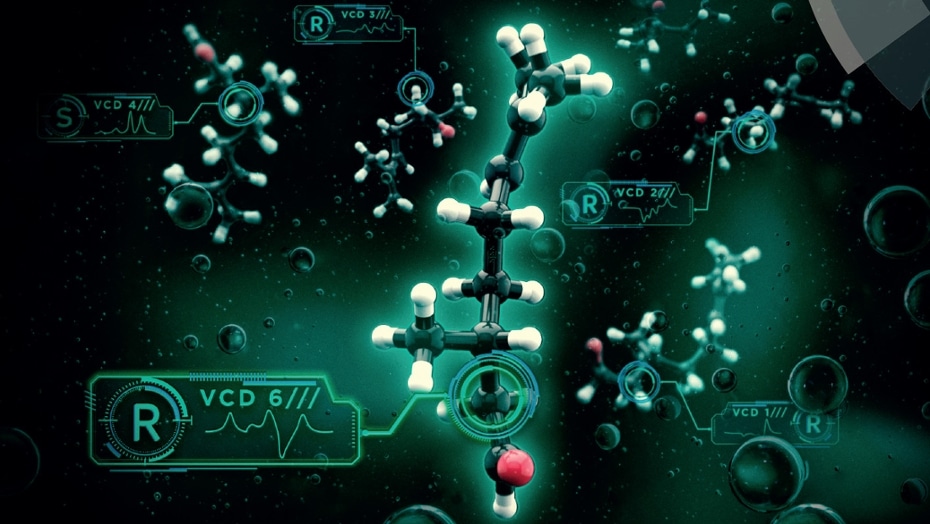Sep 4 2019
Using vibrational circular dichroism (VCD) spectroscopy, University of Amsterdam chemists have considerably enhanced the experimental determination of the “handedness” or chirality of molecules.
 (Image credit: HIMS/RSC)
(Image credit: HIMS/RSC)
A genetic algorithm allowed the chemists to “tame” the uncertainties in VCD analysis stemming from the fact that many structural conformations can be adopted by flexible molecules.
This latest improvement may lead to a large-scale application of VCD, for example, as a tool for real-time monitoring of (bio)chemical processes or for high-throughput screening of pharmaceutical compounds.
The researchers, headed by Professor Wybren Jan Buma, describe the new VCD technique in a paper that features in the September 7th, 2019, issue of Chemical Science—the leading journal of the Royal Society of Chemistry. Given its significance, the paper features on the journal cover and the ChemScience editors designate it as a “hot paper” and “pick of the week.”
It is now possible to determine the handedness of molecules much more reliably and with better quantitative measures than before.
Mark Koenis, Study First Author and PhD Student, University of Amsterdam
In the latest paper, Buma and colleagues demonstrated their innovative technique, amongst others, by performing research on citronellal. It is a standard example of the group of molecules that has often presented insurmountable challenges to VCD analysis until now.
Citronellal is chiral, implying that it can occur as a pair of molecular structures that are non-superimposable mirror images of one another—similar to a left hand and a right hand. The molecule is dynamic and flexible enough to adopt several varied spatial structures, known as conformations.
Spatial Variation Confounds Chirality Determination
Since citronellal happens to be chiral, it denotes a group of molecules of significant pharmaceutical and biochemical relevance. Similarly, since several biological molecules (like receptors, enzymes, proteins, etc.) are chiral, the chiral molecules’ “handedness” governs their biological interactions.
The chiral mirror structures (known as enantiomers) of the citronellal molecule tend to differ in their interaction with olfactory receptors so that the “right-handed” molecule smells of lemons and the “left-handed” equivalent smells of oranges. The impact of chirality can be relatively more dramatic in several other molecules.
For instance, in pharmaceutical applications, one enantiomer of a drug could have a positive therapeutic effect, whereas the other enantiomer may lead to harmful biological outcomes.
Citronellal, being dynamic and flexible, demonstrates the difficulties of chirality determination through VCD spectroscopy. Here, VCD leverages circularly polarized light that actually reveals a “handedness” in the variation existing between the right and left circular polarization. Hence, it helps in distinguishing between right-handed and left-handed molecules.
The advanced method produces a spectroscopic fingerprint that is exclusive not only for each molecule but also for each mirror image of the same molecule. In reality, for all practical purposes, VCD spectroscopy is the only method that can distinguish between enantiomers under true conditions.
However, there is a catch. Similar to citronellal, several molecules are dynamic and flexible, adopting a wide variety of spatial structures. Every structure comes with its own fingerprint, so that a real VCD spectrum represents the total of all spectroscopic fingerprints of all spatial molecular variants existing in the sample.
In addition to this, low-energy and more stable molecular variants will be present more than the higher-energy counterparts, so that all the variants do not contribute correspondingly to the VCD spectrum. Hence, the structural freedom poses a serious issue when it comes to establishing chirality in these situations.
Genetic Algorithm
In VCD analysis, one typical solution is to establish all probable conformations of the molecule being investigated, compute their energies and respective fingerprints, average these separate components, and finally compare the ensuing spectrum with the experimental VCD spectrum obtained.
However, this is far less evident than it might seem. There are several techniques, from very easy to very sophisticated, that can be used to calculate the energies of the different spatial structures.
In the worst case it might be that one type of calculation would lead to the conclusion that the molecule has one particular type of handedness, while another type of calculation would lead to the opposite conclusion.
Wybren Jan Buma, Professor, University of Amsterdam
Now, Buma’s team has considerably enhanced the “calculate and compare” approach by unequivocally considering the ambiguity in the calculated energies. With the help of a genetic algorithm that employs the principles of evolution as well as “survival of the fittest,” the researchers were able to tune the contributions of the different fingerprints such that the most optimal agreement with the empirical VCD spectrum was achieved.
The beauty of our approach is that the correct handedness always leads to better agreement with the experimental data than the opposite handedness. Even more importantly, it enables us to present a quantitative measure of the reliability of the VCD assignment.
Mark Koenis, Study First Author and PhD Student, University of Amsterdam
Increasing Opportunities for Application
The genetic algorithm was tested both on citronellal and dehydroquinidine—a chiral molecule denoting a “worst-case” scenario since it displays large dynamic structural variations.
Furthermore, it is experimentally quite harder to acquire the VCD spectrum of dehydroquinidine, and therefore, the available spectrum is of a relatively lower quality than what is usually aimed for. The outcomes demonstrate that even for such “difficult” molecules, the new technique is much better than all current approaches for complete configuration assignment.
The scientists hope that enhancing the reliability of the VCD method as an analytical tool will pave the way to many applications, including quality control, in the synthesis of pharmaceutical ingredients. The researchers have already carried out studies to establish the extent of chiral impurities by making use of the VCD method.
“We have also shown that notoriously difficult problems such as molecules with many chiral centres can be tackled,” stated Buma.
Considering the fact that VCD is low-cost and experimentally easier than other techniques, he envisages more opportunities for using this method in the development and large-scale synthesis of chiral molecules.